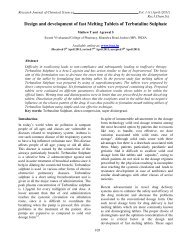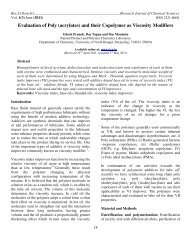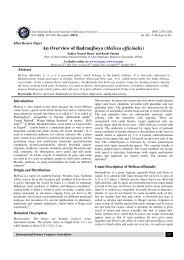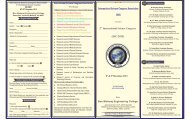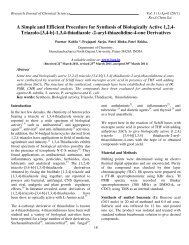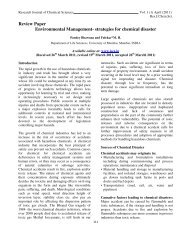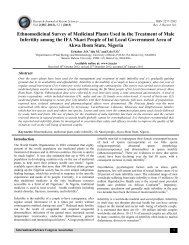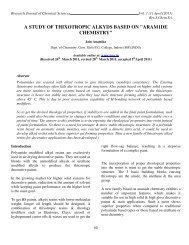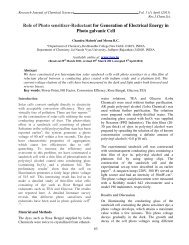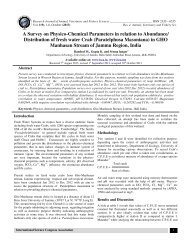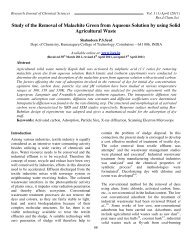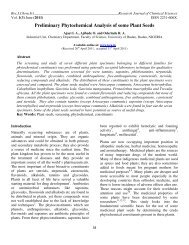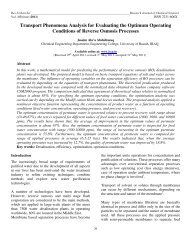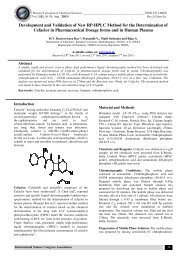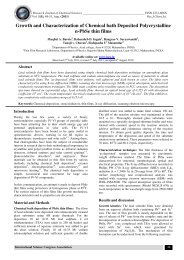Invitro Cytotoxic Activity of Marsilea Quadrifolia Linn of MCF-7 ... - ISCA
Invitro Cytotoxic Activity of Marsilea Quadrifolia Linn of MCF-7 ... - ISCA
Invitro Cytotoxic Activity of Marsilea Quadrifolia Linn of MCF-7 ... - ISCA
Create successful ePaper yourself
Turn your PDF publications into a flip-book with our unique Google optimized e-Paper software.
International Research Journal <strong>of</strong> Medical Sciences ________________________________________________________________<br />
Vol. 1(1), 10-13, February (2013)<br />
Int. Res. J. Medical Sci.<br />
DPPH radical scavenging activity: Free radical scavenging<br />
capacity was evaluated on the basis <strong>of</strong> the scavenging activity <strong>of</strong><br />
DPPH by measuring the reduction <strong>of</strong> absorbance at 517 nm 10 .<br />
Principle: The DPPH assay measures hydrogen atom (or one<br />
electron) donating activity and hence provides a measure <strong>of</strong><br />
free-radical scavenging antioxidant activity. DPPH is a purplecoloured<br />
stable free radical and will form yellow color when it<br />
was reduced as diphenyl picryl hydrazine complex.<br />
Crude methanol, aqueous and ethylacetate extracts <strong>of</strong><br />
M.quadrifolia were redissolved in methanol and various<br />
concentrations <strong>of</strong> each extract were prepared. The assay mixture<br />
contained in a total volume <strong>of</strong> 1 mL consists <strong>of</strong> 500 µL <strong>of</strong> the<br />
extract, 125 µL <strong>of</strong> freshly prepared DPPH solution (1mM in<br />
methanol) and 375 µL <strong>of</strong> solvent (methanol). The contents were<br />
mixed vigorously in a vortex mixer for 10 s and incubated at<br />
room temperature in the dark (wrapped with Aluminum foil) for<br />
30 min. The absorbance was read at 517 nm using a<br />
spectrophotometer. In each experiment, the tested sample alone<br />
in methanol was used as blank while the DPPH solution alone in<br />
methanol was used as control. All experiments were carried out<br />
in triplicate. Butylated hydroxy toluene was used as a standard.<br />
The radical scavenging activity <strong>of</strong> samples corresponded to the<br />
intensity <strong>of</strong> quenching DPPH.<br />
The results were expressed as percentage inhibition.<br />
% inhibition = [(A control – A sample)/ A control] x 100<br />
where A control and A sample are the absorbance values <strong>of</strong> the<br />
control and test sample, respectively. The effective<br />
concentration <strong>of</strong> sample required to scavenge DPPH radical by<br />
50% (EC50) was obtained by linear regression analysis <strong>of</strong> doseresponse<br />
curve plotting between % inhibition and concentration<br />
The EC50 value for each sample, defined as the concentration<br />
<strong>of</strong> the test sample leading to 50% reduction <strong>of</strong> the initial DPPH<br />
concentration, was calculated from the non linear regression<br />
curve <strong>of</strong> Log concentration <strong>of</strong> the test extract (µg ml-1) against<br />
the mean percentage <strong>of</strong> the radical scavenging activity.<br />
Evaluation <strong>of</strong> cytotoxic activity: The human Breast<br />
adenocarcinoma (<strong>MCF</strong>-7) cell line was obtained from the<br />
NCCS., Pune, India.<br />
The assay was carried out using (3-(4, 5-dimethyl thiazol-2yl)-<br />
2, 5-diphenyl tetrazolium bromide (MTT). MTT is cleaved by<br />
mitochondrial enzyme dehydrogenase <strong>of</strong> viable cells, yielding a<br />
measurable purple product formazan. This formazan production<br />
is directly proportional to the viable cell number and inversely<br />
proportional to the degree <strong>of</strong> cytotoxicity<br />
Preparation <strong>of</strong> working herbal extracts: 0.5ml <strong>of</strong> stock (100<br />
mg/ ml) herbal extract was dissolved in 4.5 ml <strong>of</strong> DMSO for a<br />
concentration <strong>of</strong> 10 mg/ ml. The fresh working suspension<br />
filtered through 0.45 µm membrane filter prior to the assay.<br />
Using the 1mg/ ml concentration herbal extract nine serial<br />
doubling dilutions <strong>of</strong> the extract <strong>of</strong> 500µl each was prepared in<br />
DMSO to get the concentration <strong>of</strong> the extract as indicated and<br />
the diluted extracts transferred to 10 wells <strong>of</strong> a 12 well culture<br />
plate. 500 µl <strong>of</strong> 48h culture <strong>of</strong> <strong>MCF</strong> 7 cell lines at a<br />
concentration <strong>of</strong> 105 cells/ ml was added to each well. Two<br />
control wells received only cell suspension without plant<br />
extract. The plate incubated in a humidified CO 2 incubator at<br />
37°C for 4 - 6 h. The plate was microscopically examined for<br />
confluent monolayer <strong>of</strong> cells, turbidity and toxicity.<br />
MTT assay 11-13 : After incubation, the medium from the wells<br />
aspirated carefully and discarded. Each well washed with<br />
Eagle’s Minimum Essential Medium (EMEM) without Fetal<br />
Calf Serum (FCS). 200µl <strong>of</strong> MTT solution (5mg MTT/ ml <strong>of</strong><br />
PBS, pH 7.2) added to each well. The plate incubated for 6-7 h<br />
at 37°C in a CO 2 incubator with 5% CO 2 . After incubation 1ml<br />
<strong>of</strong> DMSO added to each well and mixedwith pipette and left for<br />
45s at room temperature. Purple formazan formed in the wells.<br />
Cell control and solvent control were included in each assay to<br />
compare the full cell viability in cytotoxicity and antitumor<br />
activity assessments. The suspension transferred to a<br />
spectrophotometer cuvette and the optical density (OD)<br />
measured at 540nm using DMSO as blank. The % cell viability<br />
was calculated with the following formula:<br />
Cell viability % = Mean OD <strong>of</strong> wells receiving each plant<br />
extract dilution / Mean OD <strong>of</strong> control wells x 100.<br />
Results and Discussions<br />
Phytochemical Screening - Qualitative phytochemical<br />
screening <strong>of</strong> the different solventextracts <strong>of</strong> M.quadrifolia<br />
revealed the presence <strong>of</strong> carbohydrates, alkaloids, steroids,<br />
Tannins, Terpenes, Protein, Flavonoids and anthroquinone,<br />
absence <strong>of</strong> Glycosides and Saponin were summarized in the<br />
table-1 Antioxidant <strong>Activity</strong> - DPPH is one <strong>of</strong> the free<br />
radical widely used for testing preliminary radical<br />
scavenging activity <strong>of</strong> compound or a plant extract. All the<br />
three extracts (methanol, aqueous and ethylacetate) <strong>of</strong><br />
M.quadrifolia exhibited potential antioxidant activity were<br />
depicted in the figure 1.<br />
The ethylacetate extract <strong>of</strong> M.quadrifolia exhibited 50%<br />
DPPH free radical scavenging activity at the lowest<br />
inhibitory concentration (IC50 : 10µg/ml). The methanol and<br />
aqueous extracts <strong>of</strong> plant also revealed antioxidant activity<br />
with an IC50; 25µg/ml and 125µg/ml respectively, when<br />
compared to the standard butylated hydroxyl toluene (7.5µg/ml)<br />
were presented in the table 2. These results denotes the<br />
presence <strong>of</strong> antioxidant principles in the extractives.<br />
<strong>Cytotoxic</strong> activity - <strong>Invitro</strong> cytotoxic activity <strong>of</strong> methanol,<br />
aqueous and ethylacetate extracts <strong>of</strong> M. quadrifolia <strong>Linn</strong><br />
were presented in table 3 and 4. The MTT assay showed<br />
an anti-proliferative activity with a IC 50 value <strong>of</strong> <strong>MCF</strong>-7<br />
cells at 39.06 µg/ml <strong>of</strong> methanolic extracts <strong>of</strong> M.quadrifolia.<br />
Ethylacetate and aqueous extracts <strong>of</strong> M.quadrifolia showed<br />
anti-proliferative activity with an IC 50 value <strong>of</strong> 47.825 and<br />
187.5 µg/ml respectively.<br />
International Science Congress Association 11



